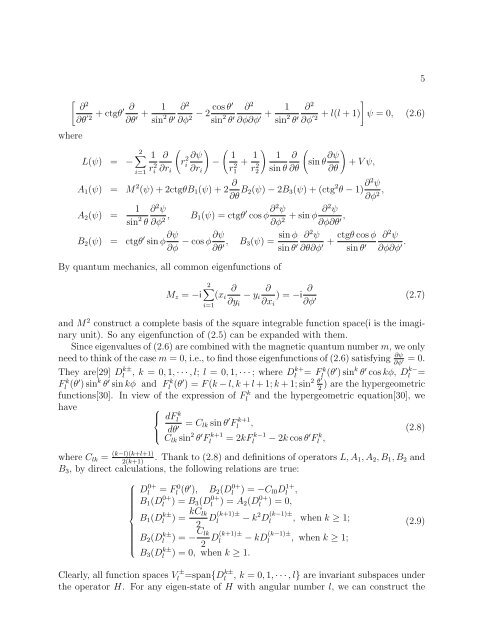Finite element calculations for the helium atom∗ 1 Introduction
Finite element calculations for the helium atom∗ 1 Introduction
Finite element calculations for the helium atom∗ 1 Introduction
You also want an ePaper? Increase the reach of your titles
YUMPU automatically turns print PDFs into web optimized ePapers that Google loves.
� ∂ 2<br />
∂θ ′ 2<br />
∂ 1<br />
+ ctgθ′ +<br />
∂θ ′ sin2 θ ′<br />
∂2 cos θ′<br />
− 2<br />
∂φ2 sin2 θ ′<br />
∂2 1<br />
+<br />
∂φ∂φ ′ sin2 θ ′<br />
5<br />
∂2 ∂φ ′ �<br />
+ l(l + 1) ψ = 0, (2.6)<br />
2<br />
where<br />
L(ψ) =<br />
2� 1<br />
−<br />
i=1 r2 �<br />
∂<br />
r<br />
i ∂ri<br />
2 � �<br />
∂ψ 1<br />
i −<br />
∂ri r2 1<br />
+ 1<br />
r2 � �<br />
1 ∂<br />
sin θ<br />
2 sin θ ∂θ<br />
∂ψ<br />
�<br />
+ V ψ,<br />
∂θ<br />
A1(ψ) = M 2 (ψ) + 2ctgθB1(ψ) + 2 ∂<br />
∂θ B2(ψ) − 2B3(ψ) + (ctg 2 θ − 1) ∂2ψ ,<br />
∂φ2 A2(ψ) =<br />
1<br />
sin2 ∂<br />
θ<br />
2ψ ∂φ2 , B1(ψ) = ctgθ ′ cos φ ∂2ψ ∂φ2 + sin φ ∂2ψ ,<br />
∂φ∂θ ′<br />
B2(ψ) = ctgθ ′ sin φ ∂ψ<br />
− cos φ∂ψ<br />
∂φ ∂θ ′ , B3(ψ)<br />
sin φ<br />
=<br />
sin θ ′<br />
∂2ψ ctgθ cos φ<br />
+<br />
∂θ∂φ ′ sin θ ′<br />
∂2ψ .<br />
∂φ∂φ ′<br />
By quantum mechanics, all common eigenfunctions of<br />
2� ∂ ∂<br />
Mz = −i (xi − yi ) = −i<br />
i=1 ∂yi ∂xi<br />
∂<br />
∂φ ′<br />
(2.7)<br />
and M 2 construct a complete basis of <strong>the</strong> square integrable function space(i is <strong>the</strong> imaginary<br />
unit). So any eigenfunction of (2.5) can be expanded with <strong>the</strong>m.<br />
Since eigenvalues of (2.6) are combined with <strong>the</strong> magnetic quantum number m, we only<br />
need to think of <strong>the</strong> case m = 0, i.e., to find those eigenfunctions of (2.6) satisfying ∂ψ<br />
∂φ ′ = 0.<br />
They are[29] D k±<br />
l , k = 0, 1, · · · , l; l = 0, 1, · · · ; where D k+ k<br />
l = Fl (θ ′ ) sink θ ′ cos kφ, D k−<br />
l =<br />
F k<br />
l (θ ′ ) sink θ ′ sin kφ and F k<br />
l (θ ′ 2 θ′<br />
) = F (k − l, k + l + 1; k + 1; sin ) are <strong>the</strong> hypergeometric<br />
2<br />
functions[30]. In view of <strong>the</strong> expression of F k<br />
l and <strong>the</strong> hypergeometric equation[30], we<br />
have ⎧<br />
⎪⎨ dF<br />
⎪⎩<br />
k<br />
l<br />
dθ ′ = Clk sin θ ′ F k+1<br />
l ,<br />
Clk sin2 θ ′ F k+1<br />
l = 2kF k−1<br />
l − 2k cos θ′ F k<br />
(2.8)<br />
l ,<br />
where Clk = (k−l)(k+l+1)<br />
2(k+1)<br />
. Thank to (2.8) and definitions of operators L, A1, A2, B1, B2 and<br />
B3, by direct <strong>calculations</strong>, <strong>the</strong> following relations are true:<br />
⎧<br />
⎪⎨<br />
⎪⎩<br />
D 0+ 0<br />
l = Fl (θ ′ ), B2(D 0+<br />
l ) = −Cl0D 1+<br />
B1(D 0+<br />
l ) = B3(D 0+<br />
l ) = A2(D 0+<br />
l ) = 0,<br />
B1(D k±<br />
l ) = kClk<br />
B2(D k±<br />
l ) = − Clk<br />
2 D(k+1)± l<br />
2 D(k+1)± l<br />
B3(D k±<br />
l ) = 0, when k ≥ 1.<br />
l ,<br />
− k 2 D (k−1)±<br />
l , when k ≥ 1;<br />
− kD (k−1)±<br />
l , when k ≥ 1;<br />
(2.9)<br />
Clearly, all function spaces V ±<br />
l =span{Dk±<br />
l , k = 0, 1, · · · , l} are invariant subspaces under<br />
<strong>the</strong> operator H. For any eigen-state of H with angular number l, we can construct <strong>the</strong>


